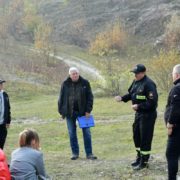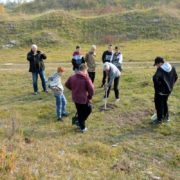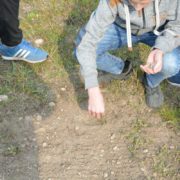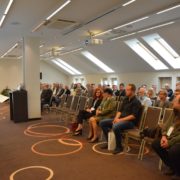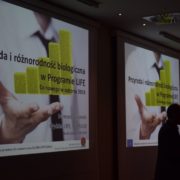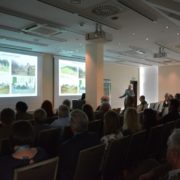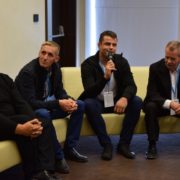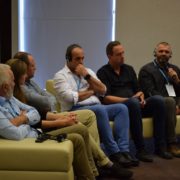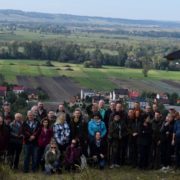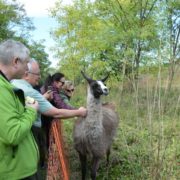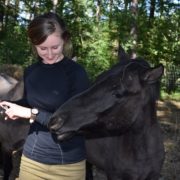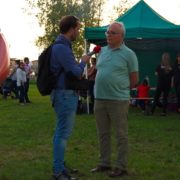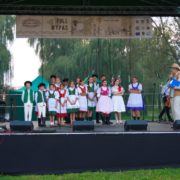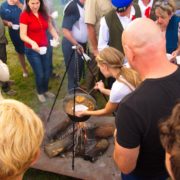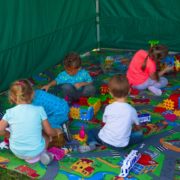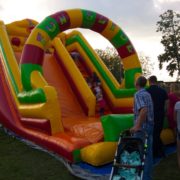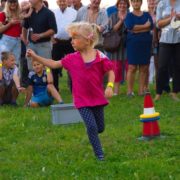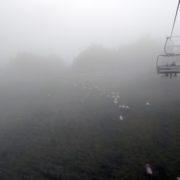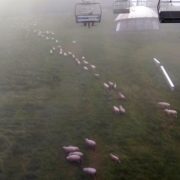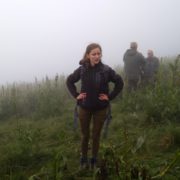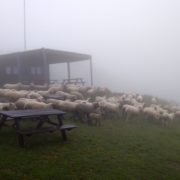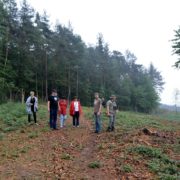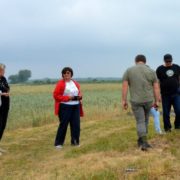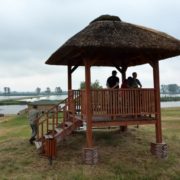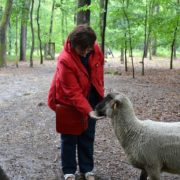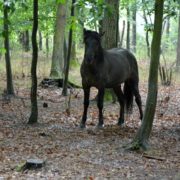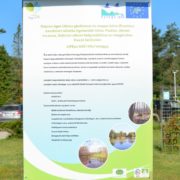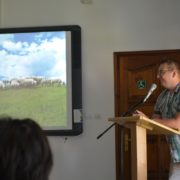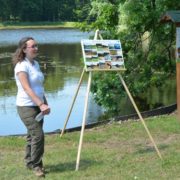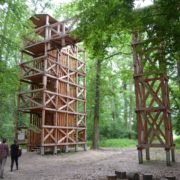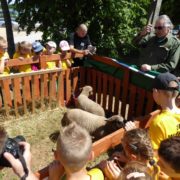Dominik
Preventive patrols on Garb Pińczowski (Pińczowski hump)
On 19 and 26 October there were preventive patrols on Garb Pińczowski. They were attended by the youth from Liceum Ogólnokształcące im. Hugona Kołłątaja w Pińczowie, Gimnazjum nr 2 w Pińczowie and Ośrodek Wychowawczy w Podzamczu Chęcińskim. They began with a lecture on nature conservation delivered by Cezary Jastrzębski, Ph.D. from the Jan Kochanowski University in Kielce. Police and fire brigade officers also delivered lectures about safety issues. Despite bad forecasts, the weather was fine, which was important for the main task that the youth had to perform, which was to boost the population of plants typical for calcareous grasslands. On nine appropriately prepared sites, the flax, carlina thistle, cornflower and catnip seeds were sown. The youth participating in patrols will be able to check the effects of their work in a few months, as it is still fall, not spring – even though the snowdrop anemone has bloomed.
The conference summarizing the project
We have summarized the four-year long efforts undertaken as part of our project. The two-day meeting in Busko Zdrój was an opportunity to talk about the effects of our actions and to discuss the future of sheep farming in Ponidzie. Several dozens of participants, including people working under LIFE projects in Greece, Belgium and Hungary, learned about the course of our project and its effects.
During the conference the following reports were presented:
“A summary of the results of the LIFE13 NAT/PL/000038 project” – Wojciech Sołtysiak, ZŚiNPK (Complex of Świętokrzyskie and the Nida River Landscape Parks) in Kielce,
“Results of nature monitoring conducted under the LIFE project” – Mariusz Simka, OBiKŚ (Ośrodek Badań i Kontroli Środowiska Sp. z o.o.) Katowice,
“Active protection – a recipe for the preservation of biodiversity” – prof. Małgorzata Jankowska-Błaszczuk from the Jan Kochanowski University in Kielce,
“Protection of Ponidzie’s natural habitats and the process of social and economic development of rural areas” – Professor Czesław Nowak from the University of Agriculture in Kraków
““Eco Service – need or necessity?” and “Small ruminants in natural environment and in culture” – Professor Andrzej Junkuszew from the University of Life Sciences in Lublin
“Biodiversity business as a tool in nature conservation” – Professor Tadeusz Zając from the Institute of Nature Conservation of the Polish Academy of Sciences
Participants discussed the social effects of restoring sheep farming in Ponidzie and methods of increasing its economic profitability
On the second day of the conference, a field trip was organized. Although there were no more sheep among the glowing oak trees in Młodzawy, the guests could still see Konik ponies lured by apples , and on the Serpentines the same interest as the sheep was aroused by the llamas grazing together with them – curious and guarding their sheep herds.
Grazing in Ponidzie
This Sunday’s picnic on the Pińczów meadows was really a grazing. The aim of our project was to promote ecological sheep farming related to the protection of xerothermic grasslands. This is the last grazing season under the project, but the sheep are already well settled in Ponidzie, the herd is growing and the grazing will be continued over the next few years for the benefit of protected grasslands and breeders.
We invited entire families and the entire families came. It was worth it, because there were attractions for everyone. The biggest one, of course, was the opportunity to admire the efficient work of sheep shearers. The weather was good, so the youngest children formed a long queue to the inflatable slide. Children could also enjoy face painting and playing with blocks. The stand of the Complex of Świętokrzyskie and the Nida River Landscape Parks (ZŚiNPK) was probably the most popular one. Here you could check your knowledge about the nature of Ponidzie, do the puzzle showing a map of landscape parks, or color a picture – for example of a stag beetle. Two song and dance ensembles: Honaj from Dursztyn-Spisz and Furmani from Bodzentyn, alternately, gave performances on the stage for four hours.
Apart from that, you could taste specialties prepared by the Farmer’s Wives Association from Kopernia, delicious cheeses from the Łukasiks' farm or lamb stew served by the “Zamek Dersława” restaurant from Busko Zdrój.
Those of you who didn’t manage to be with us yesterday can watch a short footage: sheep shearing and performances of the ensembles, but it’s a pity that you could not try the delicious stew.
Polish ponies
Polish ponies (also known as Koniks or Konik polski) are a primitive breed of small horses, whose wild ancestors were the tarpans once living in Polish and Lithuanian forests. In the Białowieża Forest they survived until the 18th century. The last wild herd was then caught. Initially, they were a natural attraction, and their regular breeding has been practiced in Poland since 1923.
Our Polish ponies feel good among the bright oak trees in Młodzawy and bravely support the herd of sheep by biting bush and undergrowth. Two stallions and three mares that came to us from the landscape parks in the zone of Pilica River have already got used to the sheep and goats that are constantly around them. The horses like to steal hay from sheep feeders. Their delicacy, however, is dry bread, and they would eat sugar cubes from one’s hand.
TVP3 Kielce footage:
http://kielce.tvp.pl/38413798/koniki-polskie-kiedys-zwane-tarpanami-biegaja-po-dabrowach
Seed plantation
Farmers complain about the hot and dry spring, but such conditions are appropriate for the plants growing on our plantation. Not surprisingly, they are steppe plants and thermophilic plants. The carlinas form flowers. The Linum hirsutum blooms beautifully in blue and the Yellow star-thistle (Centaurea solstitialis) is extremely impressive. The Serratula lycopifolia had started to shed blossom, so we begun collecting their seeds. The Dictamnus albus also shed blossom, and because it „shoots” its seeds to a distance of even a few meters, in order to collect them, we wrapped the seed bags in gauze.
Protection of Serratula lycopifolia
Serratula lycopifolia can be found in Poland only in two places in Ponidzie: in the Skorocice reserve and in Górki. It is a unique plant, which is under strict protection. After obtaining appropriate permits, we reinforced the population of Serratula lycopifolia in Skorocice within the framework of active protection. We collected the seeds last year on our plantation. Despite the drought, several dozen of individuals bravely cope on the gypsum slope in Skorocice. It can therefore be optimistically assumed that the site of this extremely rare plant will be preserved.
A conference closing the LIFE Beskidy project
On the 13th-14th of June, we took part in the conference in Ustroń, summarizing the LIFE12 NAT/PL/000081 project, titled Protection of non-forest accumulations in the Beskidy Landscapes Parks.
The programme of the conference included a presentational and an on-site part. On the first day, nine presentations were delivered, which concerned both the summary of the current activities of the project and the results of the environmental monitoring. We learned about the history of Beskidy mountain farming, possibilities of combating the Copper Tops and amphibian protection on the example of the Wigry National Park LIFE project. It was also an opportunity to present the hitherto activities of our project.
The second day of the conference took place in the area where the works on active protection were presented, at the top of Poniwiec and Mała Czantoria.
A visit of the Project Monitor
Once again, our project was visited by representatives of the European Commission. This time, besides our monitor Stanisław Tworek, we were visited by Anna McClintock – a financial officer responsible for, among others, the final accounts of LIFE projects. Together they carried out an on site inspection from the substantive, accounting and executive points of view. The activities of the project are getting closer and closer to the end, so it was an opportunity to present practically all surfaces – starting from Górki, through Skorocice (Serratula lycopifolia), Chroberska Wola (new grazing area), Garb Pińczowski, to thermophilous oak tree forests in Młodzawy.
This time, particularly interesting for the monitor were horses grazing in the forests.
A conference closing the KASZÓ LIFE project.
On the 29th-30th of May, we took part in the closing conference of the LIFE12 NAT/HU/000593 project titled KASZÓ LIFE, which was held in Kaszó. The main objective of the project, carried out by a consortium of the Kaszó Forest Enterprise and the Forestry Research Institute (ERTI), was to restore degraded forest habitats in the West-Inner-Somogy region (south-west Hungary) by improving the hydrology of the area and the water supply of forests, wetlands and meadows.
The agenda of the first day included a variety of topics: the demand for water in forests, the extreme balance of water in the Carpathian Basin and the well-being of forests. Then, we had the opportunity to learn about the nature conservation measures that had been implemented as part of the KASZÓ-LIFE project, to see the results of the activities.
The second day included topics such as the spread of invasive insect species and the impact of climate change on natural habitats. There was also an opportunity to present the results of our project so far, with a special emphasis on activities in thermophilous oak tree forests.
The conference was attended by 53 participants. 16 presentations were given: 5 international and 11 Hungarian.
Promotion in Podzamcze
The Świętokrzyskie and Nadnidziadzkie Landscape Parks Complex co-organized the „Our Home – Nature” picnic, which took place on 22th May in the Youth Educational Center in Podzamcze. More than 400 children from primary schools from the Chęcinsko-Kielecki Park took part in the event. A dozen or so institutions set up their tents and prepared presentations that were to interest the children in the environment around them.
Our blackhead sheep farm could not miss out on such an occasion. Three of this year’s sheep – one of them still entirely black – bravely endured the heat and the attempts to feed and stroke them. As always, they aroused great interest. For children and young people, it was an opportunity to have contact with the animals, and for the LIFE team it was an opportunity to provide information about the objectives and ways of implementing our project.














